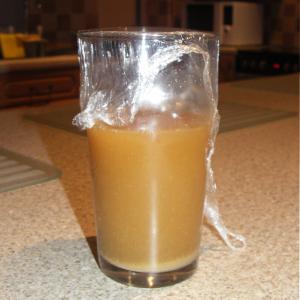Hey Revvy along those same lines, I'm looking at a RIS calling for a 6L starter, I'm thinking 2L on stirplate, decant and add 2 more, decant and add 2 more. I've only got a 2L flask. OG 1.100 Thoughts?
Three steps, 2+2+2 is not equivalent to a single 6 l step.
Wyeast has a pitching calculator that explicitly allows you to do three steps, not as many options as Mr. Malty though (and you have to know how many cells you want to pitch, it doesn't tell you).
Here is how to use the Mr. Malty calculator to do a stepped starter. This example will be a two step, but you can do it for as many iterations as you need.
1. Start with your last step. I just put in a yeast manufacture date of Nov 1, stir plate, 6 gallon, 1.100 SG. 1 yeast pack requires a 4.5 liter starter, and I can't do that on my stir plate. I will figure out how many yeast packs I need so I can make a starter in my 2 liter flask. Turns out 2 yeast packs requires a 1.82 liter starter, perfect. Now I could go buy 2 yeast packs, but I don't want to sooooooo:
2. Now I need to figure out how to grow one pack of yeast into the equivalent of two at which point I can decant and put the 1.82 liters of wort from step 1 in there and call it a day. So what I do is fiddle around with the gravity on the starter until the numbers below tell me that I need exactly 2 yeast packs without a starter (in my example, this is 1.040, this doesn't matter for anything I am just using the calculator backwards to figure out what I need to know). In addition to telling me a 1.040 wort needs 2 yeast packs, which I don't care about, it also tells me that 1 yeast pack in 1 liter of starter is the equivalent.
3. So now I just work backwards. I pitch my yeast pack into 1 liter of wort, producing the equivalent of two yeast packs. I chill and decant and then add 1.82 liters of fresh wort. Now I have as much yeast as 4.8 packs or a 4.5 liter starter with 1 pack, which is what I need for my beer.
ETA: Note that I only need 2.82 liters of wort in a two step process to get the same number of cells as 4.5 liters of wort in a one step process. So if you do 2+2+2 you will end up with way to much yeast (in fact 2+2 might be very close to enough).




















![Craft A Brew - Safale BE-256 Yeast - Fermentis - Belgian Ale Dry Yeast - For Belgian & Strong Ales - Ingredients for Home Brewing - Beer Making Supplies - [3 Pack]](https://m.media-amazon.com/images/I/51bcKEwQmWL._SL500_.jpg)









































